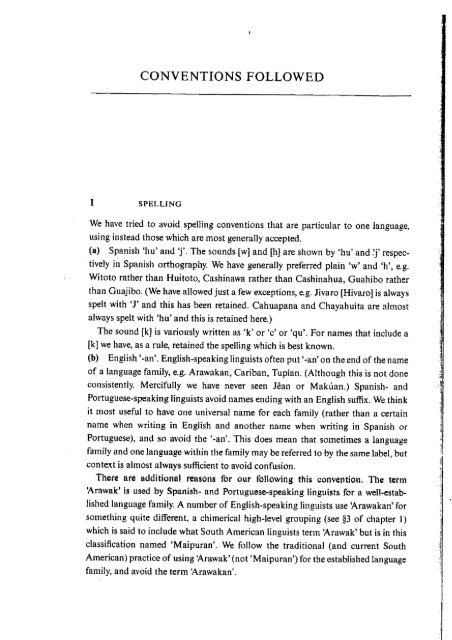The Amazonian Languages
by R.M.W. Dixon and Alexandra Y. Aikhenvald
by R.M.W. Dixon and Alexandra Y. Aikhenvald
Create successful ePaper yourself
Turn your PDF publications into a flip-book with our unique Google optimized e-Paper software.
Conventions followed<br />
xxv<br />
1<br />
CONVENTIONS FOLLOWED<br />
SPELLING<br />
We have tried to avoid spelling conventíons that are particular to one Janguage,<br />
instead those which are most generally aecepted.<br />
(a) Spanish 'hu' and 'j'. <strong>The</strong> sounds [wJ and [h1 are shown by 'hu' and:j' respectively<br />
in Spanish orthography. We have gene rally preferred plain 'w' and 'h', e.g.<br />
Witoto rather than Huitoto, Cashinawa rather than Cashinahua, Guahibo rather<br />
than Guajibo. (We have allowed just a l'ew exceptions, e.g. Jivaro [Hivaro] is always<br />
spelt with 'J' and this has been retained. Cahuapana and Chayahuita are almost<br />
always spelt with 'hu' and this is retained here.)<br />
<strong>The</strong> sound [kJ is variously written as 'k' or 'e' or 'qu'. For names that include a<br />
[k] we have, as a rule, retained the spelling which is best known.<br />
(b) English '-an'. English-speaking linguists often put '-an' on the end of the name<br />
ol' a language family, e.g. Arawakan, Cariban, Tupían. (Although this is not done<br />
cOl1sistel1tly. Mercifully we have never seen Jean or Makúan.) Spanish- and<br />
Portuguese-speaking linguists avoid names el1ding with an English suffix. We think<br />
it most useful to have one universal name for eaeh family (rather than a certain<br />
name when writing in English and another name when writing in Spanish or<br />
Portuguese), and so avoid the '-an'. This does mean that sometimes a language<br />
family and one langllage within the family may be referred lO by the same label, bul<br />
context is almost always sufficient to avoid eonfusion.<br />
<strong>The</strong>rct are additionl1l rcta50llS ror O\lf following this conventioo. <strong>The</strong> term<br />
'Arawak' is used by Spanish- and Portllgllese-speaking Iinguists for a well-established<br />
language family. A number of English-speakíng lingllists use 'Arawakan' ror<br />
something quite dilferent, a ehimerical high-level grouping (see §3 of chapter 1)<br />
whieh is said to ínclude what South American lingllísts term 'Arawak' but is in Ihis<br />
c1assífieation named 'Maipuran'. We follow the traditional (and eurrent South<br />
American) pracliee of using 'Arawak' (not 'Maipuran') for the established language<br />
family, and avoid the term 'Arawakan'.<br />
2 LANGUAGE ANO OIALECT, FAMILY ANO SUBGROUP<br />
(a) <strong>The</strong> tenn 'Ianguage' can be llsed with two quite dilferent meanings. Qne is the<br />
linguistie sen se, when forms of speech that are mutually unintelligible are designated<br />
to be distinet languages. Two forms of speech that are mutually intelligible<br />
are then dialects of one language. <strong>The</strong> other is the political sense, when eaeh separate<br />
natíon or tribe likes to say that it has íts own language. <strong>The</strong> two sen ses of 'language'<br />
often give the same result butsometimes they do not. Qne linguísticlanguage<br />
may relate to severaI politieal languages, as when the Swedish and Norwegian<br />
peoples eaeh say that they have a distinet language, whereas these are mutually intelligible<br />
and are thus, on linguístic grounds, dialeets of a single language. Or one<br />
politieallanguage may relate to severallínguistie languages as when the Chinese say<br />
that they aIl speak the Chinese language, but in a number of dialects. In raet the<br />
'dialects' are not mutllally intelligible and are, on Iingllistie eriteria, separate languages.<br />
In this book we employ the term 'language' in the Iinguistie sen se. Note that<br />
earlier work on South Ameriea has lIsed the term 'language' sometimes in the Iinguistie<br />
and sometimes in the polítieal sense. Forinstanee, there are seven Makú<br />
tri bes, eaeh of whieh has its own politieallanguage, but there are just four separate<br />
languages in the linguistie sen se. Yanomami has sometimes been deseribed as<br />
involving fourclose!~ related languages, but it seems most appropriate to eharacterize<br />
Yanomami as a dialeet eontinuum (elfectively, as a single language). Within the<br />
Arawá fami1y, Jamamadi, Jarawara and Banawá are distinct tribes and have been<br />
said to involve distinet languages (indeed, there are eurrently three missionary<br />
teams, each working on its own Bible translation). In faet these speech forms have<br />
abollt 95 per cent voeablllary in eommon and very similar grammars. Eaeh is easily<br />
intelligible to speakers of the others and they are c1early dialeets of one language,<br />
on linguistie eriteria. Within the Tupí-Guaraní subgroup there is sorne eonfusion<br />
about what is a language and what ís a dialect; the eommentary on table 5.1<br />
attempts to provide sorne clarifieation.<br />
(b) We have tried to enSllre that the standard eriteria for proving genetie relationship<br />
between languages are followed in this book. <strong>The</strong> established rerm for a group<br />
of langllages that is genetically related is 'language family'. Srnaller genetic grollps<br />
within a family are ealled 'branehes' or 'subgroups' of the family. For instance, one<br />
talks of rhe Germanic braneh, or slIbgroup, wirhin the Indo-European family.<br />
Terms sueh as 'stock' and 'phylum' (together with 'micro-phylum', 'macro-phylum',<br />
'meso-phylum') go with the quite different methodology or lexieostatisties and are<br />
best avoided. We thus talk of the Tupí-Guaraní branch, or subgroup, of the Tupí<br />
language family, and so on. (<strong>The</strong> Portuguese term tronco is sometimes translated


















